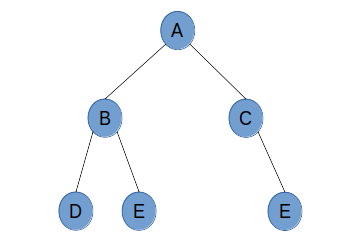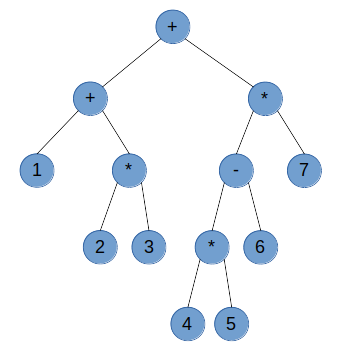抽象数据类型(ADT)-二叉树
二叉树定义
二叉树是一种特殊的树,对于树中的每一个结点,最多只有两个儿子的树称为二叉树。如图:

二叉树的实现
因为二叉树的每个结点只有两个儿子,因此可以把在每个结点中记录下儿子的指针,为了方便查找,还可以记录下每个结点的父结点指针。
数据结构定义:
#define ELEMENT_TYPE int
#define BINTREE_OK (0)
#define BINTREE_FAIL (-1)
typedef struct binTree {
struct binTree* parent;
struct binTree* left;
struct binTree* right;
ELEMENT_TYPE data;
}tagBinTree;
可以定义一些二叉树的操作:
// 创建二叉树根结点
tagBinTree* createTree(ELEMENT_TYPE rootValue);
// 销毁二叉树
void disposeTree(tagBinTree* root);
// 添加结点为左儿子
tagBinTree* addLeft(tagBinTree* parent, ELEMENT_TYPE value);
// 添加结点为右儿子
tagBinTree* addRight(tagBinTree* parent, ELEMENT_TYPE value);
tagBinTree* binTreeMallocNode(ELEMENT_TYPE value)
{
tagBinTree* node = (tagBinTree*)malloc(sizeof(tagBinTree));
if (node == NULL)
return NULL;
node->data = value;
node->parent = NULL;
node->left = NULL;
node->right = NULL;
return node;
}
void binTreeFreeNode(tagBinTree* node)
{
free(node);
}
tagBinTree* createTree(ELEMENT_TYPE rootValue)
{
printf("[createTree]element size:%d\n", sizeof(ELEMENT_TYPE));
return binTreeMallocNode(rootValue);
}
void disposeTree(tagBinTree* root)
{
if (root == NULL)
return ;
disposeTree(root->left);
disposeTree(root->right);
free(root);
}
tagBinTree* addLeft(tagBinTree* parent, ELEMENT_TYPE value)
{
if (parent == NULL)
return NULL;
tagBinTree* node = binTreeMallocNode(value);
if (node == NULL)
return NULL;
if (parent->left != NULL) {
node->left = parent->left;
parent->left->parent = node;
}
parent->left = node;
node->parent = parent;
return node;
}
tagBinTree* addRight(tagBinTree* parent, ELEMENT_TYPE value)
{
if (parent == NULL)
return NULL;
tagBinTree* node = binTreeMallocNode(value);
if (node == NULL)
return NULL;
if (parent->right != NULL) {
node->right = parent->right;
parent->right->parent = node;
}
parent->right = node;
node->parent = parent;
return node;
}
表达式树
表达式树就是一种二叉树,它的所有叶子结点都是操作数,其它结点都是操作符。下面是一棵表达式树:

上述表达式树是由表达式 1+2*3+(4*5-6)*7 转化来的。
我们可以通过后缀表达式来构建一棵表达式树。这里也需要用到栈的数据结构,注意此时栈中要存储的数据为指针,需要定义 #define ELEMENT_TYPE void*。上述表达式的后缀表达式为 123*+45*6-7*+。构建时从左到右扫描后缀表达式,当遇到操作数时,则创建一个树结点放到到栈中,当遇到一个操作符时,创建一个树结点,并从栈中弹出两个树结点,当做此操作符结点的左右儿子,然后将该操作符结点放入栈中,直到扫描完整个表达式,栈中应该只有一个操作符结点,即为该表达式树的根结点。
代码实现:
tagBinTree* createTreeFromReversePolish(char* notation, int length)
{
ttStack* stack = stackInit();
tagBinTree* root = NULL;
for (int i = 0; i < length; i++) {
if (notation[i] == '+' || notation[i] == '-' || notation[i] == '*' || notation[i] == '/') {
tagBinTree* node = binTreeMallocNode(notation[i]);
if (node == NULL) {
printf("[createTreeFromReversePolish]malloc error\n");
continue;
}
tagBinTree* left = NULL, *right = NULL;
if (!stackEmpty(stack))
right = pop(stack);
if (!stackEmpty(stack))
left = pop(stack);
if (left != NULL)
left->parent = node;
if (right != NULL)
right->parent = node;
node->left = left;
node->right = right;
push(stack, node);
} else {
tagBinTree* node = binTreeMallocNode(notation[i]);
push(stack, node);
}
}
if (!stackEmpty(stack))
root = pop(stack);
stackDestory(stack);
return root;
}
参考:
<数据结构与算法分析-C语言描述> P4